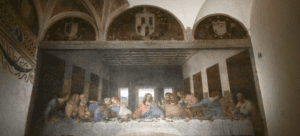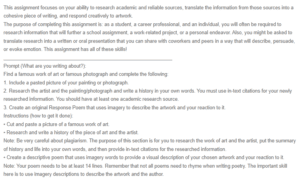Descriptive Imagery Response – The Last Supper

“The Last supper” painted by Leonardo Da Vinci
Without a doubt, the painting is one of the most famous paintings of all time. This painting depicts a scenario that shows Jesus Christ and his disciples having a last meal together. It is assumed that it was painted between the years 1495 and 1498 by the famous painter Leonardo da Vinci and is regarded as “…one of the most important mural paintings in the history, and the painting technique is considered to be different from the common fresco technique based on the previous investigation…” (Fukunaga, 2020). The painting was done for a monastery in Dominica. The monastery is known as Santa Maria Delle Grazie in the city of Milan.
It is essential to point out that the painting describes a famous meal that Jesus had with his disciples. These dramatic scenes are portrayed more closely in the first four books of the New Testament of the Bible. In the Bible story of Matthew 26:21-28, he mentions that one of his disciples would betray him to those who will crucify him. In this mural, laying focuses on Leonardo’s belief that gesture, posture, and expression have to portray the perceptions of the mind. In this case, all of the disciples are seen showing distinct reactions to the assertion of Jesus concerning his betrayal befitting their personality (Fukunaga, 2020). Consequently, the consequence is one complex study of the distinct human emotions, which are portrayed in a cunningly simple composition.
Besides, the subject of this painting was a preferred selection for the refectory walls of monasteries during the 15th Century in Italy, in which nuns and monks preferred to have their meals before the portrait of Jesus’ last repast. In this mural painting, the version that Leonardo depicts is neatly portrayed, whereby Jesus is at the center before a large extensive table, and the Apostles flanking him on his right and left. He is seen dressed in traditional blue and red wear and sporting a beard. Intriguingly, the painter did not give Christ the customary halo like other painters of Jesus. A section of scholars argues that the light from the window works as a substitute for the halo. Another faction disputes this claim and maintains that the seen pediment lines above the window serve to create the illusion of the halo. Still, it has been argued by another section of scholars that the missing halo serves to show that Jesus is still human and would inevitably suffer the pain of Passion. Do you need help with your assignment ? Get in touch with us at eminencepapers.com.
Besides, the mural was commissioned by Duke of Milan Ludovico Sforza and Leonardo’s patron during the extended stay of Leonardo’s in Milan. When one pays close attention to the painting, Sforza’s coat of arms is apparent with the family’s initials on three lunettes, which are on top of the mural. It is clear that Leonardo most likely began working on this endeavor, and as is his norm, he worked slowly on the project, pausing between the sessions until he finished in 1498. Given that Leonard was a perfectionist, the ideal fresco painting was not popular because this process demanded that an artist apply the paints quickly and with fresh plaster (Vasari et al., 2019). Conversely, Leonardo tried a new tact that involved an experimental technique that used oil paint on a two-layer of dried ground that is preparatory. As such, his process was compromised, implying that these pigments could not be attached to the walls on a permanent basis. However, this painting started to flake after several years. Its deterioration was further enhanced by steam and smoke from the kitchen of the monastery, as well as soot from the candles of the refectory and the location’s dampness.
Furthermore, in the following centuries, there were sustained culminating damages, especially in 1652 when a door was cut directly through the north wall of the monastery that resulted in the cutting of Jesus’ feet, as well as the paint and plaster, becoming loose (Vasari et al., 2019). However, there were restorative efforts that involved heavy-handed retouches and the application of varnish, solvents, and glue. There was additional irreverence when Napoleon attacked Milan and used the refectory as the stable.
Lastly, when there was a flood during the 19th century, there was an infestation of molds on the painting that further diminished the quality. After the bombings during World War II, the painting suffered its most severe damage that entailed a collapse of a wall section. It was then rebuilt and completed in 1999. As such, it goes without a trace of a doubt that Leonardo is among one of the most celebrated painters of all time.
The Famous Meal
A day like any other, it was
He sat before the table, his faithful earthlings on either side
Keenly giving a listen
Their eyes are a depiction of horror, fear, terror, and confusion
At the revelation that one of them would betray the Great
One wonders why. Another marvels how? While yet another realizes it is His Will
Adorned in blue and red regalia, a depiction of royalty, he appears royal
The absence of the halo, an implication of the human nature that the Chosen One has
His peaceful, quiet and composed facial features is a direct contrast to that of his disciple
A deep look and one can tell there is disquiet.
A keen focus and one cannot shake away the feeling of dread
Dread that the inevitable is about to happen
Dread that the end is nigh
But then, that is the ultimate goal
References
Fukunaga, K., Hosako, I., Palazzo, M., Dall’Aglio, L., Aramini, F., Cucci, C., … & Duling, I. N. (2020, November). Terahertz time-domain imaging of “The Last Supper.” In 2020 45th International Conference on Infrared, Millimeter, and Terahertz Waves (IRMMW-THz) (pp. 1-2). IEEE.
Vasari, G., Bandello, M., Giovio, P., da Vinci, L., & di Castiglione, S. (2019). Lives of Leonardo Da Vinci. Getty Publications.
ORDER A PLAGIARISM-FREE PAPER HERE
We’ll write everything from scratch
Question 

Descriptive Imagery Response – The Last Supper
This assignment focuses on your ability to research academic and reliable sources, translate the information from those sources into a cohesive piece of writing, and respond creatively to artwork.
The purpose of completing this assignment is: as a student, a career professional, and an individual, you will often be required to research information that will further a school assignment, a work-related project, or a personal endeavor. Also, you might be asked to translate research into a written or oral presentation that you can share with coworkers and peers in a way that will describe, persuade, or evoke emotion. This assignment has all of these skills!
______________________________________________________________
Prompt (What are you writing about?):
Find a famous work of art or famous photograph and complete the following:
1. Include a pasted picture of your painting or photograph.
2. Research the artist and the painting/photograph and write a history in your own words. You must use in-text citations for your newly researched information. You should have at least one academic research source.
3. Create an original Response Poem that uses imagery to describe the artwork and your reaction to it.
Instructions (how to get it done):
• Cut and paste a picture of a famous work of art.
• Research and write a history of the piece of art and the artist.
Note: Be very careful about plagiarism. The purpose of this section is for you to research the work of art and the artist, put the summary of history and life into your own words, and then provide in-text citations for the researched information.
• Create a descriptive poem that uses imagery words to provide a visual description of your chosen artwork and your reaction to it.
Note: Your poem needs to be at least 14 lines. Remember that not all poems need to rhyme when writing poetry. The important skill here is to use imagery descriptions to describe the artwork and the author.
